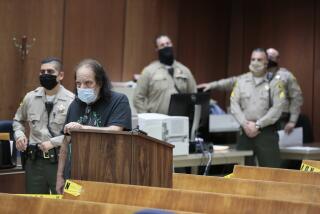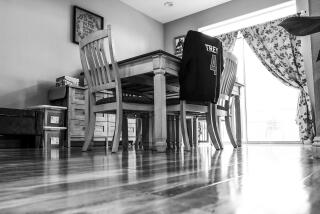The Tragic Aftermath of Near-Drownings
- Share via
At a time when other boys his age are outside playing baseball and working up enough courage to call a girl on the telephone, 13-year-old Jeremy James Readinger can neither walk nor talk.
The dark-haired boy, nicknamed J.J., needs someone to feed him and change his diaper. He lets people know by his facial expressions or by crying if he doesn’t like something. And when he does like something, he will smile brightly or make babbling sounds. Developmentally, his physical therapist says, he’s at the same stage as a 6-month-old.
Jeremy was a perfectly healthy and normal little boy until 1978, when, at age 2 1/2, he was pulled from the bottom of a relative’s Jacuzzi.
“I work at a junior high school, and Jeremy would be there right now,” said Jeremy’s mother, Judy Buckley of Mission Viejo. “I see all the other kids going to dances and going to all these things, and I know he’s never going to do that.”
Near-drowning victims who suffer severe brain damage--including the two surviving toddlers who fell into a swimming pool in North Tustin last Thursday while under the care of a baby-sitter--face years of care and physical therapy in which improvement may be measured only by degrees.
And the families will never be the same.
“It changes their lives,” said Sharon Grady, a Fountain Valley physical therapist who works with near-drowning victims. “You’re taking families that had a child that was running around playing one day and the next day they’re faced with somebody telling them their child has irreversible brain damage. So it puts them into a whole new world. Many of them don’t even know what ‘brain damage’ means.”
In 1988 five children under the age of 5 died in Orange County due to drowning, according to the Orange County Trauma Society. So far this year, there have been three deaths, including one of the three toddlers who fell into the North Tustin baby-sitter’s pool.
Grady said the degree of brain damage in near-drowning victims varies. “Actually, you’re looking at a range from those who are severely handicapped physically and mentally to those who recover completely. And you have every range in between.”
Once a brain-damaged child is able to leave the hospital, parents are faced with the choice of taking care of the child themselves at home or putting the child in an institution, such as the state-run Fairview Developmental Center in Costa Mesa or a private care facility for the developmentally disabled.
Although not all families are financially or physically able to take care of a severely brain-damaged child, Grady said, the majority of the nearly 40 near-drowning survivors she has worked with live at home and are being taken care of by their parents.
“I feel if they have any chance for recovery, being in that stimulating environment and in familiar surroundings is going to help their overall recovery. And love. There’s nothing like a mother’s love.”
For Wendy and Steven Heiner of Huntington Beach, the only acceptable option was to take care of their son, Jeffrey, themselves after his accident.
While visiting her mother in May, 1987, Wendy Heiner went inside the house to tend to her infant son, Ricky, who was upstairs crying. She thought 2-year-old Jeffrey was right behind her. He wasn’t. She found him floating face down in the back-yard swimming pool.
Jeffrey spent 5 weeks in the hospital before coming home.
“My husband and my feelings were if Jeffrey were to get better he’d get better at home,” said Heiner. “That’s saying nothing against a hospital, but they’re only capable of taking care of so much at one time. At home, the child’s in a happier environment.
“Physically and mentally it’s very difficult. It was very hard on my husband to watch this adorable child go through such suffering.”
In the first few months after Jeffrey came home, his mother had to provide round-the-clock care, adhering to a strict schedule of feeding and medication. Although she had help from relatives, she said, “I was just so tired and exhausted.”
She said that taking care of Jeffrey today is like taking care of a toddler. “He has to be fed, and his diapers have to be changed. He likes to be entertained because he can’t do a lot on his own. He doesn’t want to just sit there.”
Jeffrey, who must use a special wheelchair that supports him at the chest and hip, recently started attending a preschool for handicapped children. And 3 days a week, his mother takes him to a 90-minute physical therapy session.
“It’s a real workout--a lot of physical stretching of every part of the body,” said his mother, who also works with Jeffrey for 10 or 15 minutes at a time throughout the day. “You stretch the body or do a sequence of rolling on a bolster or a rubber ball. We do (the stretching exercises) constantly. You’re sitting with Jeffrey on your lap, and it’s something like an unlearned response: You automatically do it, stretching his hands and arms.”
Over the past 2 years, she said, Jeffrey has made progress.
“To us, on a daily basis we don’t always see the big changes,” she said. “But friends or family who don’t see him every day say, ‘My gosh, I don’t believe the change.’ So he has made great strides, but we still have a long way to go.
“It’s just very hard, but it’s very much worth it when you watch the smile that suddenly starts to come back and he starts to laugh again at the same old things.
“We’re one of the luckier ones.”
When Jeremy Readinger nearly drowned, his mother had an 18-month-old daughter and an older son to take care of and was unable to care for Jeremy at home. As soon as he was released from the hospital, he was moved into a private residential facility for the developmentally handicapped in Garden Grove.
Grady, who serves as physical therapist for both Jeremy and Jeffrey, said there is no way to tell how much brain damage Jeremy or any near-drowning victim has suffered. “They’re like a person imprisoned in a body. They know the people around them, they respond. I can be gone and J.J. knows me. He’ll hear my voice in the hall and will turn toward the voice. He won’t do that for other people.”
One of the biggest problems with children who have severe physical disabilities, Grady said, is managing them to prevent severe deformities as they get older. Because he was beginning to develop curvature of the spine, Jeremy must wear a back brace while sleeping and when he’s not in his special wheelchair. Like many near-drowning survivors, he also suffers from a seizure disorder and must be watched carefully.
Buckley, who had remarried shortly before Jeffrey’s accident, said both she and her husband, Gary, still go through periods of guilt. Although she did not seek professional counseling after the accident, she said, she talked frequently with her minister. “I’d go in there and pour out my tears,” she said.
Buckley and her family visit Jeremy on weekends and bring him home on the weekend once or twice a month and on holidays. That’s when Buckley takes over doing the movement exercises and feeding, a 30-minute procedure at each meal.
And if Jeremy cries out in the middle of the night, she is able to comfort him.
“I go and lie in bed with him because he can’t communicate and can’t say, ‘I hurt, I want my diaper changed,’ or whatever. So I’ll just sit there and hold him and rock him until he falls back asleep.”
The hardest part is taking him back to the residential facility.
“He can tell when we bring him back and we put him in his room,” she said. “He cries. He knows. And it’s very hard for me to say, ‘I’ve got to go.’ That’s the part that hurts. And wondering if he’s getting the proper care and stuff: When he’s sick, you wonder, are they taking care of him, are they giving him the proper medication? It’s the same with every mother.”
Nearly 11 years after his accident, Jeremy has shown some improvement. Buckley still maintains a sense of hope, however small now, that he’ll recover.
“You have to have that hope,” she said.
Unlike some people who may think near-drowning survivors face a fate that is worth than death, Buckley said she has never felt that way.
“I have a friend who lost her son in an automobile accident,” she said. “She was talking to me after she heard about Jeremy’s accident and she asked me, ‘Don’t you think he would rather have died than just be a total vegetable?’ I said, ‘No. At least I have somebody to hold and love and kiss.’ ”
More to Read
Sign up for Essential California
The most important California stories and recommendations in your inbox every morning.
You may occasionally receive promotional content from the Los Angeles Times.













